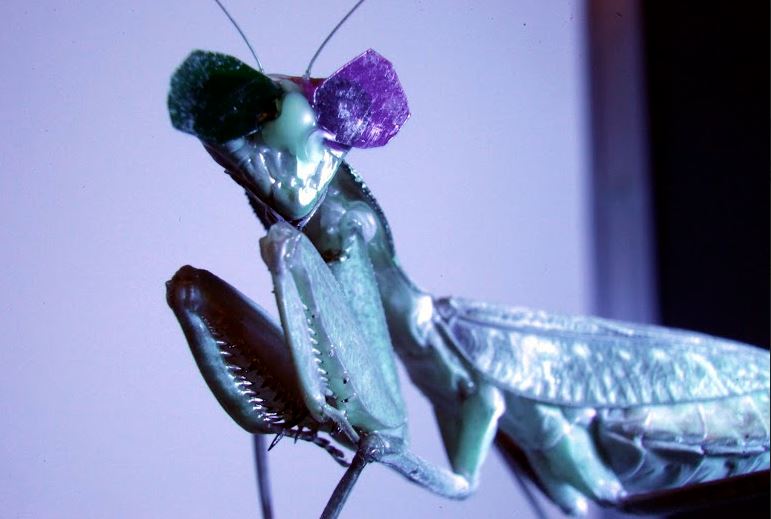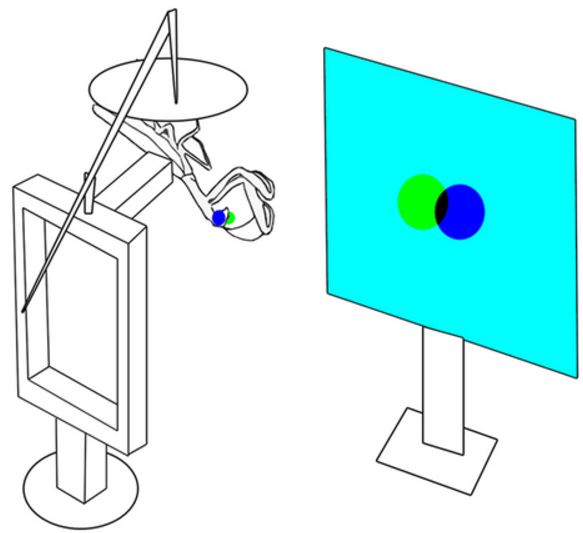Insects have 3D vision, scientists found after fitting some praying mantises with special tiny ‘insect-cinema’ glasses. The researchers, from Newcastle University, said mantises use 3D perception (stereopsis) for hunting. This is the first comprehensive study to compellingly show that invertebrates have 3D vision.
Stereoscopy (binocular vision) is the ability to focus and align both eyes accurately on something, and then combine the visual images from each eye into a single, clear 3D perception. Humans have 3D vision. 3D vision allows you to tell how far or near objects are.
The findings in this latest study, which scientists wrote about in the academic journal Scientific Reports, provide a new model to improve visual perception in robots.
 One of the praying mantises wearing the miniature 3D glasses, which were fitted using beeswax. (Image: Newcastle University)
One of the praying mantises wearing the miniature 3D glasses, which were fitted using beeswax. (Image: Newcastle University)
Most of our knowledge regarding 3D vision has come from vertebrates. However, study leader, Jenny Read, Professor of Vision Science, and colleagues can now confirm that the praying mantis, an invertebrate, does have 3D vision. Vertebrates like mammals, birds and reptiles have a backbone (spinal column), while invertebrates such as insects, snails, crabs, etc. do not.
The researchers made special tiny 3D glasses for the mantises. Human 3D glasses have red and blue lenses – those of the mantises, which have poor red light vision, had one blue and one green lens.
A better understanding of 3d vision
3D vision in praying mantises was first shown in 1983 by Samual Rossel, from the Department of Zoology at the University of Zürich, who wrote about his work in the journal Nature. In his work he used prisms and occluders, which meant that a very limited set of images could be shown.
In this latest study, thanks to the special miniature 3D glasses, the scientists could show the insects any images they wanted – this has opened up new avenues of research.
Prof. Read, who is supported by the Leverhulme Trust, said:
“Despite their minute brains, mantises are sophisticated visual hunters which can capture prey with terrifying efficiency. We can learn a lot by studying how they perceive the world.”
“Better understanding of their simpler processing systems helps us understand how 3D vision evolved, and could lead to possible new algorithms for 3D depth perception in computers.”
 The praying mantis does not hunt when it has just 2D vision, the researchers found. (Image: Newcastle University)
The praying mantis does not hunt when it has just 2D vision, the researchers found. (Image: Newcastle University)
Mantises only hunt when they have depth perception
In the experiment, the mantises were fitted with mini glasses attached with beeswax. They were shown short videos of simulated bugs on a computer screen.
When the bugs were in 2D, the mantises made no attempt to catch them. However, when they saw them in 3D, seemingly floating in front of the screen, the mantises went for them. This proves that mantises do indeed use 3D vision.
Initially, they utilized the most popular 3D technology currently used for humans – utilizing circular polarization to separate the two eyes’ images. This did not work, because the mantises were so near the screen that the glasses were unable to separate the two eyes’ images correctly.
 The ‘insect 3D cinema’ for the display of stereoscopic stimuli to the mantis. (Image: nature.com)
The ‘insect 3D cinema’ for the display of stereoscopic stimuli to the mantis. (Image: nature.com)
Dr. Vivek Nityananda, a sensory biologist at Newcastle University, said:
“When this system failed we looked at the old-style 3D glasses with red and blue lenses. Since red light is poorly visible to mantises, we used green and blue glasses and an LED monitor with unusually narrow output in the green and blue wavelength.”
“We definitively demonstrated 3D vision or stereopsis in mantises and also showed that this technique can be effectively used to deliver virtual 3D stimuli to insects.”
The research team now plans to examine the algorithms used for depth perception in insects to gain a better understanding of how human vision evolved, and to find ways of adding 3D technology to robots and computers.
Citation: “Insect stereopsis demonstrated using a 3D insect cinema,” Vivek Nityananda, Ghaith Tarawneh, Ronny Rosner, Judith Nicolas, Stuart Crichton & Jenny Read. Scientific Reports 6, Article number: 18718 (2016). Published online 07 January 2016. DOI: 10.1038/srep18718.
Video – Miniature glasses confirm 3D vision in insects
This Newcastle University video shows that invertebrates do indeed use stereopsis or 3D perception for hunting.
